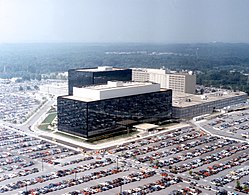National Security Agency
Appearance
(Redirected from NSA)
 National Security Agency surveillance |
|---|
 |
 Seal of the National Security Agency | |
 Flag of the National Security Agency | |
 NSA headquarters building in Fort Meade, Maryland, c. 1986 | |
| Agency overview | |
|---|---|
| Formed | November 4, 1952[1] |
| Preceding agency |
|
| Headquarters | Fort Meade, Maryland, U.S. (39°6′32″N 76°46′17″W / 39.10889°N 76.77139°W) |
| Motto | "Defending Our Nation. Securing the Future." |
| Employees | Classified (est. 30,000–40,000)[2][3][4][5] |
| Annual budget | Classified (est. $10.8 billion, 2013)[6][7] |
| Agency executives |
|
| Parent agency | Department of Defense |
| Website | nsa.gov |
The National Security Agency (NSA) is part of the US government and is responsible for the global monitoring, collection, and processing of information and data for domestic and foreign intelligence and counterintelligence purposes, and specializes in a discipline known as signals intelligence (SIGINT). The agency is also tasked with protecting U.S. communications networks and information systems. NSA was started in 1952, and its main office is in Maryland.
Its stated goal is to protect the US people by
- Worldwide "earsdropping," secretly listening to what people are saying in other countries. It monitors, collects, decodes, translates and analyses information and data. That is known as signals intelligence (SIGINT).
- Protecting the US from eavesdropping and SIGINT spying by foreign governments and agencies, called "penetration and network warfare."[9][10] The agency does so by clandestine (secret) means,[11] such as bugging electronic systems,[12] and sabotaging their computer networks with viral software.[13][14]
Related pages
[change | change source]References
[change | change source]- ↑ Burns, Thomas L. (1990). "The Origins of the National Security Agency" (PDF). United States Cryptologic History. National Security Agency. p. 97. Archived from the original (PDF) on March 22, 2016. Retrieved August 23, 2016.
- ↑ "60 Years of Defending Our Nation" (PDF). National Security Agency. 2012. p. 3. Archived from the original (PDF) on 2013-06-14. Retrieved July 6, 2013.
On November 4, 2012, the National Security Agency (NSA) celebrates its 60th anniversary of providing critical information to U.S. decision makers and Armed Forces personnel in defense of our Nation. NSA has evolved from a staff of approximately 7,600 military and civilian employees housed in 1952 in a vacated school in Arlington, VA, into a workforce of more than 30,000 demographically diverse men and women located at NSA headquarters in Ft. Meade, MD, in four national Cryptologic Centers, and at sites throughout the world.
- ↑ Priest, Dana (July 21, 2013). "NSA growth fueled by the need to target terrorists". The Washington Post. Archived from the original on February 16, 2014. Retrieved July 22, 2013.
Since the attacks of Sept. 11, 2001, its civilian and military workforce has grown by one-third, to about 33,000, according to the NSA. Its budget has roughly doubled.
- ↑ Cite error: The named reference
Introvwas used but no text was provided for refs named (see the help page). - ↑ Cite error: The named reference
employeeswas used but no text was provided for refs named (see the help page). - ↑ Gellman, Barton; Greg Miller (August 29, 2013). "U.S. spy network's successes, failures and objectives detailed in 'black budget' summary". The Washington Post. p. 3. Archived from the original on September 1, 2013. Retrieved August 29, 2013.
- ↑ Shane, Scott (August 29, 2013). "New Leaked Document Outlines U.S. Spending on Intelligence Agencies". The New York Times. Archived from the original on August 30, 2013. Retrieved August 29, 2013.
- ↑ Nakashima, Ellen; Strobel, Warren (2025-04-04). "National Security Agency and Cyber Command chief Gen. Timothy Haugh ousted". The Washington Post. Archived from the original on 2025-04-04.
- ↑ "About NSA: Mission". National Security Agency. Retrieved September 14, 2014.
- ↑ Nakashima, Ellen. January 26, 2008. Bush order expands network monitoring. The Washington Post. Retrieved February 9, 2008. [1]
- ↑ Executive Order 13470 — 2008 Amendments to Executive Order 12333, United States Intelligence Activities, July 30, 2008 (PDF)
- ↑ Malkin, Bonnie. NSA surveillance: US bugged EU offices. The Daily Telegraph, June 30, 2013
- ↑ Ngak, Chenda. NSA leaker Snowden claimed U.S. and Israel co-wrote Stuxnet virus Archived 2013-09-27 at the Wayback Machine, CBS, July 9, 2013
- ↑ Bamford, James. The Secret War, Wired Magazine, June 12, 2013.
- Official NSA website
- NSA for kids Archived 2006-06-15 at the Wayback Machine
Further reading
[change | change source]- Bamford, James, The Puzzle Palace, Penguin Books, ISBN 0-14-006748-5.
- Bamford, James, The Shadow Factory, Anchor Books, 2009, ISBN 978-0-307-27939-2.
- Church Committee, Intelligence Activities and the Rights of Americans: 1976 US Senate Report on Illegal Wiretaps and Domestic Spying by the FBI, CIA and NSA, Red and Black Publishers (May 1, 2008).
- Hanyok, Robert J. (2002). Spartans in Darkness: American SIGINT and the Indochina War, 1945–1975. National Security Agency. Retrieved November 16, 2008.
- Aid, Matthew, The Secret Sentry: The Untold History of the National Security Agency, 432 pages, ISBN 978-1-59691-515-2, Bloomsbury Press (June 9, 2009).
- Shaker, Richard J. "The Agency That Came in from the Cold." (Archive, Archive #2) Notices. American Mathematical Society. May/June 1992 pp. 408–411.
- Jackson, David (June 18, 2013). "Obama: NSA surveillance programs are 'transparent'". USA Today. Retrieved June 18, 2013.
- "National Security Agency Releases History of Cold War Intelligence Activities." George Washington University. National Security Archive Electronic Briefing Book No. 260. Posted November 14, 2008.
- "The NSA Files". The Guardian. London. June 8, 2013.
